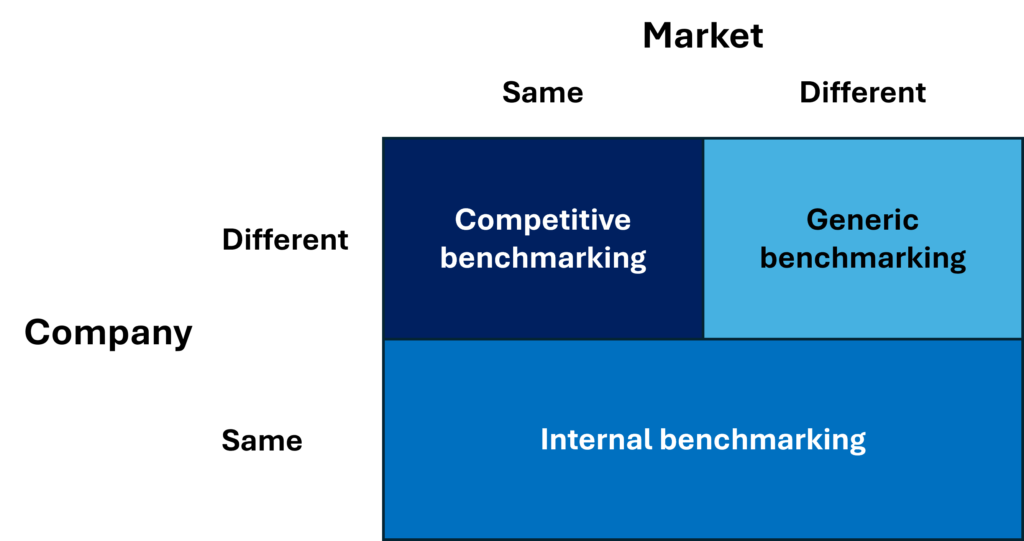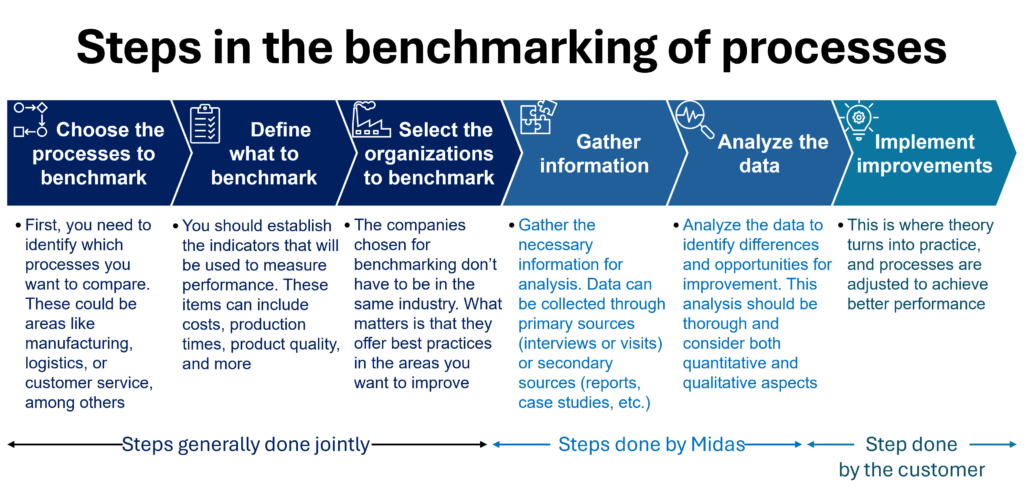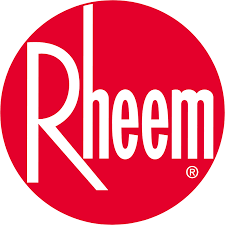
In today’s world, where competition is fiercer than ever, companies are constantly looking for ways to improve their processes and products. This is where benchmarking becomes an essential tool for identifying best practices, optimizing performance, and staying competitive. In this blog post, we’ll explore the benchmarking process in detail and how it can help companies innovate and stand out in the market.
What is Benchmarking?
Benchmarking is a process to compare products, services, or processes with those of organizations recognized as leaders in their field. The goal is to identify improvement opportunities and adopt best practices to boost efficiency and performance.
One key concept in benchmarking is that you don’t always have to compare yourself with companies in the same industry. Sometimes, it’s more beneficial to learn from related or even completely different industries that have excelled in areas you want to improve. For example, a manufacturing company could benefit from studying the logistics practices of a tech company.
What are Benchmarking’s main Benefits?
The main benefits that you might expect from benchmarking are:
- Set Realistic Goals: Benchmarking helps you set realistic goals by using real-world examples. Instead of guessing, you can base your targets on the proven success of others, ensuring your objectives are both ambitious and achievable. It keeps you focused on what’s possible.
- Eliminate Blind Spots: Benchmarking opens your eyes to areas you might overlook. By comparing your processes with others, you can spot inefficiencies or gaps that weren’t obvious before. It helps you tackle hidden weaknesses, ensuring continuous improvement and growth.
- Save Resources: By learning from the best, benchmarking saves you time and money. There’s no need to reinvent the wheel when you can adopt practices that have already been proven effective. It’s a shortcut to improvement without wasting precious resources.
Types of Benchmarking
There are different types of benchmarking, each with its own focus. Here are the most common ones:
- Competitive Benchmarking: This focuses on comparing the processes and products of companies that compete in the same market. It’s especially useful for understanding how direct competitors operate and finding ways to outperform them. However, gathering information can be tricky and often requires the help of external consultants.
- Generic Benchmarking: This approach focuses on studying the performance of a specific function, regardless of the industry. It’s helpful when you want to learn from companies that, while not direct competitors, have demonstrated excellence in relevant areas.
- Internal Benchmarking: This type of benchmarking is done within the same organization. The idea is to compare the practices of different departments or business units to identify the best ones and apply them across the organization. It’s common in multinational companies that aim to standardize processes and improve internal efficiency.
In a nutshell, the difference between benchmarking types is:

Steps for Conducting a Benchmarking
Our benchmarking process follows a structured set of steps to ensure that the analysis is thorough and effective.
You can absolutely handle the benchmarking process on your own, but bringing in a consultant can make a big difference, especially when it comes to gathering and analyzing the data. We recommend working with a consultant like Midas, as we’re not only experienced in this process but also ensure that everything is done in full compliance with legal and ethical standards.
Now, let’s dive into each step in more detail.
- Choose the Processes to Benchmark: Start by selecting the specific areas you want to focus on, whether it’s manufacturing, logistics, R&D, or something else. It’s important to pick the processes that will make the biggest impact on your performance.
- Define What to Benchmark: Once you’ve chosen the processes, decide on the specific metrics to measure. These could include things like overall costs, variable costs, team size, R&D investments, and so on. The goal here is to track what truly matters to your business.
- Select Organizations to Benchmark: The companies you compare yourself to don’t always have to be in the same industry. Sometimes, looking at organizations from completely different sectors—ones known for their operational excellence—can provide fresh insights and innovative ideas.
- Gather information: This step involves collecting data, both primary (e.g. interviews or visits) and secondary (reports, case studies, etc.). This where Midas excels, doing it in a legal and ethical way, and making sure that the sources are credible and that the methods respect confidentiality.
- Analyze the data: Now that we have the information, it’s time to dive deep. We compare the data, identify the differences, and uncover opportunities where you can enhance your processes and performance.
- Implement Improvements: Finally, take what you’ve learned from our report and put it into action. Adjust your processes to align with the best practices we’ve identified and continuously monitor your progress to ensure ongoing improvement.
A key aspect is that, ideally, benchmarking should be used to leapfrog the competitors, finding to new ways to surpass them.
In the following chart we show this process:

Strengths of Benchmarking
Benchmarking has numerous advantages that make it a powerful tool for companies. Below are some of its key strengths:
- Realistic Goals: It provides a simple and direct way to set achievable goals based on the performance of other companies.
- Eliminates Blind Spots: By comparing your own processes with those of other organizations, you can identify areas for improvement that may not have been considered before.
- Flexibility: It’s an extremely flexible methodology that can be applied to different areas of an organization.
- Resource Saving: By adopting the best practices of other companies, you save resources by not having to reinvent the wheel.
- Culture of Innovation: It fosters an open-minded culture within the company, as new ideas are constantly sought from external sources.

Weaknesses of Benchmarking
Despite its many strengths, benchmarking is not without its challenges and limitations. Some of its weaknesses include:
- Difficulty in Obtaining Information: In the case of competitive benchmarking, it can be difficult to access competitor information in an ethical and legal way.
- Tendency Toward Mediocrity: By copying other companies’ best practices, there’s a risk that the organization will settle for reaching the same performance level as competitors, rather than striving for true innovation.
- Variable Results: What works for one company may not necessarily work for another. Contexts and circumstances can be very different.
- Tactical Focus: Benchmarking tends to be more of a tactical tool than a strategic one, limiting its application at higher levels of management.

Practical Example of Benchmarking in Innovation
One of the most relevant cases of benchmarking in innovation occurred when a client wanted to understand the innovation process of its main competitor in the region, as it was being significantly outperformed.
The process included data gathering through interviews with various key players, such as distributors, retailers, suppliers, and target customers. The analysis revealed that the key competitor had decentralized its innovation process, allowing it to be more agile and quickly adapt to market demands.
Based on these findings, our client was able to adjust its own process, shifting from centralized innovation to a more decentralized approach, resulting in a significant improvement in its ability to innovate and launch new products to market.

Conclusion
In summary, benchmarking is a powerful tool for companies looking to improve their competitiveness and drive innovation. By comparing your own processes with those of the best companies, you can identify improvement opportunities that might otherwise go unnoticed.
However, it’s important to remember that benchmarking should be used as a guide, not a rigid formula. Every company is unique, and what works for one won’t necessarily work for another. The key is to adapt best practices to your organization’s specific needs.
If you want to take your company to the next level and make the most of benchmarking, don’t hesitate to contact our experts. We’re here to help you identify the best opportunities and implement improvements that will allow you to stand out in the market.
Knowing the benefits and benchmarking is one thing, but carrying it out smoothly and successfully is another. Don’t worry, we’re here to help every step of the way!
We’ve been where you are, needing benchmarking to cope with tough competitors
After conducting over 250 projects, we’ve perfected our approach. We’re passionate about helping companies like yours leapfrog your competitors!

Benefits that you can expect:
Set Realistic Goals
Eliminate Blind Spots
Save Resources
Benchmarking helps you set ambitious yet achievable goals based on proven success, keeping your targets realistic and focused
By comparing processes, benchmarking reveals hidden inefficiencies, helping you identify and fix overlooked weaknesses for continuous improvement
Benchmarking saves time and money by adopting proven best practices, eliminating the need to develop solutions from scratch
Here is what our customers say about our work:
Some of our customers:
How to move forward:
Schedule a quick call
In a brief call, we’ll ask for some basic information to create a custom proposal for you. Once it’s ready, we’ll send it your way for review. Once approved, we’ll get started on your project
Receive your benchmarking
During the project, you’ll receive at least two key deliverables:
First, we’ll share preliminary findings and adjust the project based on your actual needs
Then, we’ll deliver our final recommendations
Outperform your competitors
By following our recommendations, you’ll be able to leapfrog your competition!
We’re ready when you are! Let’s work together to achieve your goals!
If you’ve read this far, it means you’re interested! We’d love to send you a free checklist for conducting your own benchmarking. Just drop your email below, and we’ll send it right over!
If you liked this blog post, please share it in your networks:








